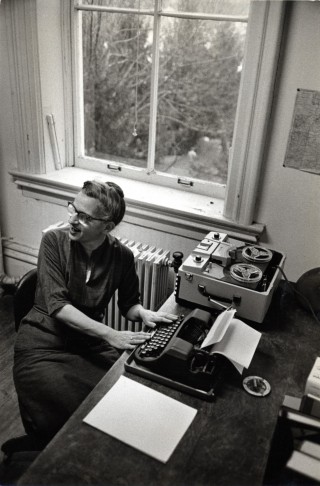[et_pb_section admin_label=”section”][et_pb_row admin_label=”row”][et_pb_column type=”4_4″][et_pb_text admin_label=”Text” background_layout=”light” text_orientation=”left” text_line_height=”1.4em” use_border_color=”off” border_color=”#ffffff” border_style=”solid”]
The Ozark Folksong Collection was recently featured in the University of Arkansas’s video series “Short Takes.” Among the more than 4600 recordings available digitally through the collection—the largest collection of Ozark folksongs available anywhere—there are several examples of folk songs and stories from the African American tradition in Arkansas.

October 25, 1953, Mary Celestia Parler, the Chaucer scholar and leader of the Arkansas Folklife Research project, visited the Long Grove Baptist Church in Woodruff County, Arkansas. After being introduced to the congregation who she was recording during her visit, Parler shared a significant message from the University during that era of racial segregation:
“…I want you to know that the campus of the University of Arkansas is the state of Arkansas, and that the University of Arkansas is not the white University of Arkansas, but the University of all the people. You brought it up (turning to the pastor), but I forgot I had a different colored skin from the rest of you. I hadn’t thought about [it] but you brought it up.”
Parler then recorded the entire service including several songs, the sermon, and call and response with the congregation. In this twelve minute portion of the recording, the preacher builds the increasingly musical sermon up to the point where the congregation then joins into a rendition of the spiritual, “I’m on the Battlefield for my Lord.” The song begins at approximately minute 10:50.
The University of Arkansas Libraries recently opened the digitized collection of folksongs, originally recorded by the Arkansas Folklore project from 1949 to 1966.

Among the other African Americans whose voices are preserved through the project is pioneering educator and former slave, Charlotte Stephens of Little Rock. Irene Carlisle made the recordings on May 17, 1951, just seven months before the legendary Arkansas educator died. There are 11 recordings available from Charlotte Stephens, including three examples of Stephens speaking about her experience in the state. In this recording, Mrs. Stephens sings the spiritual “Get up in the chariot,” explaining how the choruses work and when she first learned the song at a church revival in the 1870s.
More information about Charlotte Stephens is available through the poster series, “Amazing African American Leaders of Arkansas.” The posters highlight five distinguished citizens of Arkansas and include biographical information, resource lists, and sample curricula.
In 2005, folklorist Rachel Reynolds Luster compiled a list of 120 songs contributed by African American informants in the Parler collection. Most of those songs are spirituals, and provide invaluable insight into the importance of the Parler project as a documentation of more than just Ozarks folk music. As Luster discovered, many of the songs from the African American musical tradition in Arkansas are available nowhere else.
The collection also includes a number of songs related to racial history that are not reflective of African American culture in Arkansas including pantomime and exploitation songs and other racist works. Users should keep in mind the possibility of encountering offensive subject matter when using the digital collection.

The selections in the Ozark Folksong Collection from African American informants show the desire of Parler and other collectors to document the entirety of Arkansas, not just the Ozarks. Several of the selections come from the delta counties and from southern Arkansas cities such as Pine Bluff. Although the recordings of African American folk music in the collection are primarily sacred songs, there are a few examples of songs from other traditions, such as the Blues. Examples of these include A.D. Robinson of Burdett, Arkansas, singing songs popularized by recording artists including “Cotton Pickin’ Blues” and “Mad Woman Blues,” among other contributions.

The folklore project captured some songs performed by African American Arkansans that have transcended separations between genres to become part of America’s shared musical language. Some became well known to wider audiences only after the work of folk music collectors across the country such as Parler. Examples in the collection include Sadie Spencer singing “O, Mary Don’t you Weep” in 1962. Other songs are recognized around the world as examples of American folk culture such as “John Henry,” sung here by Bailey Dansley, an African American from southeast Arkansas. Other examples of “John Henry” in the collection come from white Ozark singers included the legendary Booth Campbell of Cane Hill, Arkansas.
The collection is full of treasures waiting to be discovered among the thousands of recordings, and the award-winning website allows users to search the collection in ways that were never before possible, including by keywords in the transcripts of the lyrics and by recording locations. Although we highlight here songs from the African American tradition, there are also songs by migrant workers, immigrants to the Ozark wine-making community, and immigrants from England, Scotland, Poland, Lithuania, Switzerland, and France, as well as the unrivaled collection of ballads and traditional songs preserved by Ozark settlers. And you now have the chance to dive-in to this collection from anywhere in the world.
For more information about the Ozark Folksong Collection or any of the other resources on Arkansas history or culture preserved by the University of Arkansas Libraries, please contact Special Collections at specoll@uark.edu or 479.575.8444.
[/et_pb_text][/et_pb_column][/et_pb_row][/et_pb_section]
